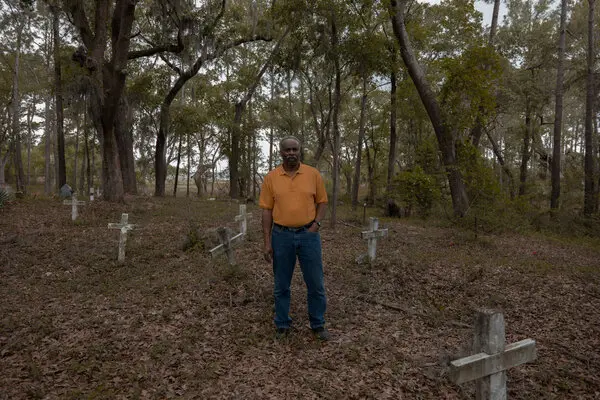A Photographer in Search of Forgotten Burial Sites
Share
Explore Our Galleries
Breaking News!
Today's news and culture by Black and other reporters in the Black and mainstream media.
Ways to Support ABHM?
By Caroline Gutman, The New York Times
An African American burial ground project in South Carolina is just one subject in Caroline Gutman’s search for a history hiding in plain sight.

I first heard about the unmarked African American burial sites in Charleston, S.C., in November 2021, while visiting the city to research an entirely different topic: I was there to photograph the legacy of indigo in the United States and its role in slavery.
A historian there told me the location of a potter’s field in the middle of Charleston that held the remains of over 26,000 people, most of whom were Black. I was familiar with the site; seeking Wi-Fi during my research, I had visited a community center that now sits on the land. There were also two baseball diamonds, two parking lots, a playground and a college football stadium named after a Confederate officer.
But there was no memorial acknowledging the remains that existed underground.
On my way out of Charleston, I stopped at the site to photograph those ball fields and parking lots. I couldn’t stop thinking about the history they obscured. On my drive home to Philadelphia, I wondered what other unmarked African American burial grounds existed in the United States. I didn’t know it then, but I had started a photography project that continues today.
Across the country, African American burial grounds have been paved over by parking lots, performance halls and highways. Some have a marker; other sites have been erased or forgotten.
My reporting first brought me to a strip mall in northeast Baltimore, where a Food Depot, Dollar General and Shoppers World sat on top of the remains of over 10,000 graves. The former site, Laurel Cemetery, was a prominent African American burial ground for over a century before it was closed in 1958. In Philadelphia, an African American burial site also known as the Bethel Burying Ground was in my old neighborhood. I learned of unmarked graves in Ellicott City, Md., and Washington, D.C. The more I asked, the more sites people told me about.
You can learn more Black history from the comfort of your home by visiting our online exhibits.
We discuss more burial grounds in our breaking news section.









Comments Are Welcome
Note: We moderate submissions in order to create a space for meaningful dialogue, a space where museum visitors – adults and youth –– can exchange informed, thoughtful, and relevant comments that add value to our exhibits.
Racial slurs, personal attacks, obscenity, profanity, and SHOUTING do not meet the above standard. Such comments are posted in the exhibit Hateful Speech. Commercial promotions, impersonations, and incoherent comments likewise fail to meet our goals, so will not be posted. Submissions longer than 120 words will be shortened.
See our full Comments Policy here.